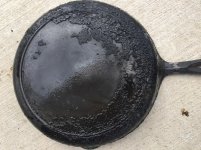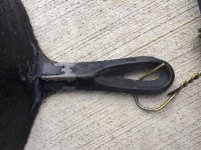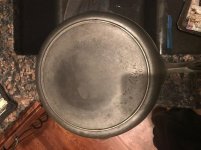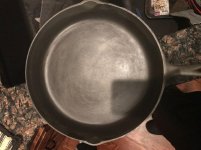-
If a web search for the answer to your cast iron cookware question has brought you directly to this forum, the information you seek may be covered in one of the many reference topics featured on the main website.
Quick Links: · Main Website · How to Identify Unmarked Pans · All About Cleaning & Seasoning · Reproductions & Counterfeits · Commonly-Used Terms
You are using an out of date browser. It may not display this or other websites correctly.
You should upgrade or use an alternative browser.
You should upgrade or use an alternative browser.
Info on Skillet
- Thread starter JHayes
- Start date
W. Hilditch
Active member
There may be a #10 BSR under there.
Hilditch
Hilditch
Good job.
I gotta say, I'm a BSR guy. I have that exact same skillet, exact same markings, and it is my favorite GP user; if I could only have one CI skillet it would be that one.
I also find it quite interesting from a historical perspective for several reasons.
You can date it as being post mid-'70s because of the size marking. BSR holloware was originally sized to match stoves from Atlanta Stove Works (their parent company), and thus were a bit larger than the corresponding size numbers from other manufacturers.
That said, the standard story is that manufacturers stopped grinding the cooking surface smooth some time after they switched to automated production. But, though BSR switched to automation in 1966-1967, the cooking surface of this skillet is still ground smooth. So, this shows that BSR continued that practice well after the switch.
I also have a BSR #12 that was produced in the late '60s, shortly after the switch to automation and inclusion of "Made in USA" markings. In comparison, the #12 is much thicker/heavier and crudely finished, such as the grinding off of flashing / side gate mark. And though the cooking surface of the #12 is ground smooth, it is not nearly as well done as on this later #10.
To me this shows how BSR continued to refine their manufacturing process after the switch to automation. The early automation piece compares quite unfavorably to pre-automation Red Mountain examples, but this later #10 has been refined to the point where it much more closely matched pre-automation quality. Not perfectly, but much more closely.
Finally, the markings - it has been commented that BSR markings were inconsistent and using them for dating pieces should be more guideline than gospel. This pan shows a couple of variations from what was normal for that period.
First, it lacks "Made in USA", even though BSR started including that mark in the late '60s. Why, who knows? But it does reinforce that the "Made in USA" markings were for marketing purposes and not because of any regulation. I have a different piece of the same era that also lacks that marking, and a piece that has it.
Then, BSR is said to be unique in their use of "IN" to abbreviate "inch" and "NO" to abbreviate "number". Though this skillet uses the "IN" abbreviation, it lacks the "NO" abbreviation. Again, why, who knows? But it is another example of their inconsistency with their markings.
OK I'm spent. Hopefully you find this as interesting as I do. Regardless, hope you enjoy the skillet.
I gotta say, I'm a BSR guy. I have that exact same skillet, exact same markings, and it is my favorite GP user; if I could only have one CI skillet it would be that one.
I also find it quite interesting from a historical perspective for several reasons.
You can date it as being post mid-'70s because of the size marking. BSR holloware was originally sized to match stoves from Atlanta Stove Works (their parent company), and thus were a bit larger than the corresponding size numbers from other manufacturers.
That said, the standard story is that manufacturers stopped grinding the cooking surface smooth some time after they switched to automated production. But, though BSR switched to automation in 1966-1967, the cooking surface of this skillet is still ground smooth. So, this shows that BSR continued that practice well after the switch.
I also have a BSR #12 that was produced in the late '60s, shortly after the switch to automation and inclusion of "Made in USA" markings. In comparison, the #12 is much thicker/heavier and crudely finished, such as the grinding off of flashing / side gate mark. And though the cooking surface of the #12 is ground smooth, it is not nearly as well done as on this later #10.
To me this shows how BSR continued to refine their manufacturing process after the switch to automation. The early automation piece compares quite unfavorably to pre-automation Red Mountain examples, but this later #10 has been refined to the point where it much more closely matched pre-automation quality. Not perfectly, but much more closely.
Finally, the markings - it has been commented that BSR markings were inconsistent and using them for dating pieces should be more guideline than gospel. This pan shows a couple of variations from what was normal for that period.
First, it lacks "Made in USA", even though BSR started including that mark in the late '60s. Why, who knows? But it does reinforce that the "Made in USA" markings were for marketing purposes and not because of any regulation. I have a different piece of the same era that also lacks that marking, and a piece that has it.
Then, BSR is said to be unique in their use of "IN" to abbreviate "inch" and "NO" to abbreviate "number". Though this skillet uses the "IN" abbreviation, it lacks the "NO" abbreviation. Again, why, who knows? But it is another example of their inconsistency with their markings.
OK I'm spent. Hopefully you find this as interesting as I do. Regardless, hope you enjoy the skillet.
Thanks for this, Eric. The first skillet I found to be collectible was a small BSR, and I've had a soft spot for them ever since. I haven't found a lot of info on them, so this was a good read. I saved it. :icon_thumbsup:
This is an excellent site for general CI knowledge and info about Griswold and Wagner in particular. Doug is practically a CI oracle.
But BSR, though not belittled, doesn't seem to get as much attention. I try to contribute to the site by answering the BSR questions that I can, though I'm still learning. Aside from my personal experience with my meager collection, my main source of BSR info is modemac. As honestly as modemac expresses himself, I'm still trying to figure out exactly how accurate it is, though I certainly don't claim superior knowledge.
If you want to learn a lot more about BSR, his main info site is here. Note the five links to additional pages near the top:
http://www.modemac.com/cgi-bin/wiki.pl/Birmingham_Stove_and_Range
And also note he cites this site for further reference...
W. Hilditch
Active member
Eric, I respect your posts and BSR info as it has helped me understand what I have even if it isn’t what I wanted to hear. Thank you.
Hilditch
Hilditch





